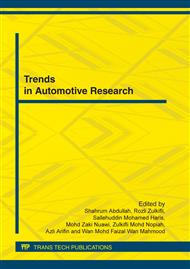[1]
R. Sarani, A. Roslan, and N. Saniran, ADSA fact sheet vol. 1, Malysian Institute of Road Safety Research (MIROS), May (2011).
Google Scholar
[2]
M.J. Flannagan, M. Sivak, and E.C. Traube, Quantifying the direct field of view when driver-side rearview mirrors, SAE 1999-01-0656.
DOI: 10.4271/1999-01-0656
Google Scholar
[3]
G. Platzer, An FMVSS 111 compliant driver's side mirror incorporating a blind zone viewing section, SAE 2006 – 01 – 1291.
DOI: 10.4271/2006-01-1291
Google Scholar
[4]
EEC directive 71/ 127/ EEC (directive on the approximation of the laws of member states relating to the rear-view mirrors of motor vehicles) as amended by directive 79/795/EEC, 85/205/EEC, 86/562/EEC, 87/354/EEC, and 88/321/EEC.
DOI: 10.54648/ijcl1992038
Google Scholar
[5]
J.A. Fisher, and I.A.R. Galer, The effects of decreasing the radius of curvature of convex external rear view mirrors upon drivers' judgments of vehicles approaching in the rearward visual field, Ergonomics, 27 (12), (1984), 1209-1224.
DOI: 10.1080/00140138408963603
Google Scholar
[6]
H. Hecht, and J. Brauer, Convex rear view mirrors compromise distance and time-to-contact judgements, Ergonomics, 50, 4 (2007), 601-614.
DOI: 10.1080/00140130601154954
Google Scholar
[7]
J. Luoma, M. Sivak, and M.J. Flannagan, Effects of nonplanar driver-side mirrors on lane-change crashes, Transportation Human Factors, 2, (2000), 279-289.
DOI: 10.1207/sthf0203_7
Google Scholar
[8]
T. Ayres, L. Li, D. Trachtman, and D. Young, Passenger-side rear-view mirrors: driver behavior and safety, Intl. J. Industrial Ergonomics, 35, (2005), 157-162.
DOI: 10.1016/j.ergon.2004.05.009
Google Scholar
[9]
A. Higashiyama, Y. Yokoyama, and K. Shimono, Perceived distance of targets in convex mirrors, Japanese Psychological Research, 43, (2001), 13-24.
DOI: 10.1111/1468-5884.00155
Google Scholar
[10]
A. Higashiyama, and K. Shimono, Mirror vision: Perceived size and perceived distances of virtual images, Perception & Psychophysics, 66, (2004), 679-691.
DOI: 10.3758/bf03194911
Google Scholar


